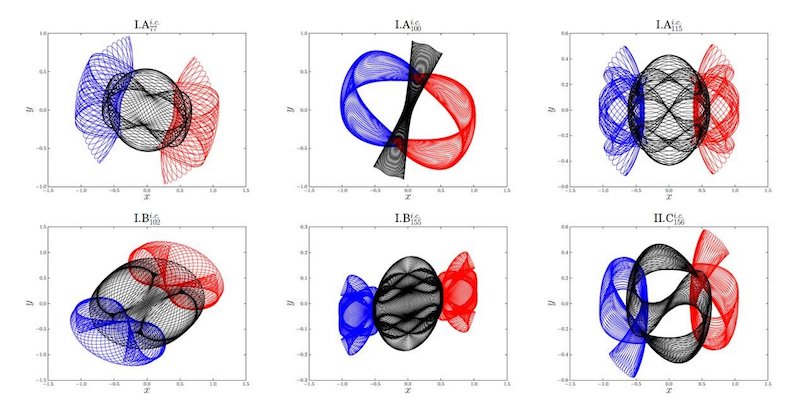 Brief overview of the six newly-found families of periodic three-body orbits. Blue line: orbit of Body-1; red line: orbit of Body-2; black line: orbit of Body-3 Credit: ©Science China Press
Brief overview of the six newly-found families of periodic three-body orbits. Blue line: orbit of Body-1; red line: orbit of Body-2; black line: orbit of Body-3 Credit: ©Science China Press
Oct. 12, 2017 (Phys.org) -- The famous three-body problem can be traced back to Isaac Newton in 1680s.
Studies on the three-body problem led to the discovery of the so-called sensitivity dependence of initial condition (SDIC) of chaotic dynamic systems.
Today, chaotic dynamics are widely regarded as the third great scientific revolution in physics in the 20th century, comparable to relativity and quantum mechanics. Thus, studies on the three-body problem have very important scientific significance.
In 1890, Poincare determined that trajectories of three-body systems are commonly non-periodic, i.e. not repeating. This can explain why it is so hard to obtain the periodic orbits of three-body systems. In the 300 years since the three-body problem was first recognized, only three families of periodic orbits had been found.
In 2013, Suvakov and Dmitrasinovic [Phys. Rev. Lett. 110, 114301 (2013)] made a breakthrough, finding 13 new distinct periodic orbits belonging to 11 new families of the Newtonian planar three-body problem with equal mass and zero angular momentum.
Now, two scientists, XiaoMing Li and ShiJun Liao at Shanghai Jiaotong University, China, have successfully determined 695 families of periodic orbits of the same Newtonian planar three-body system using the TH-2 supercomputer at Guangzhou, China.
Their results have been published in SCIENCE CHINA-Physics Mechanics & Astronomy. Videos of these orbits are available here.
(more)
READ MORE: Phys.org











